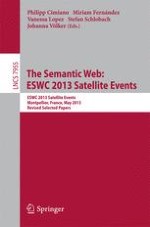2013 | Buch
The Semantic Web: ESWC 2013 Satellite Events
ESWC 2013 Satellite Events, Montpellier, France, May 26-30, 2013, Revised Selected Papers
herausgegeben von: Philipp Cimiano, Miriam Fernández, Vanessa Lopez, Stefan Schlobach, Johanna Völker
Verlag: Springer Berlin Heidelberg
Buchreihe : Lecture Notes in Computer Science
